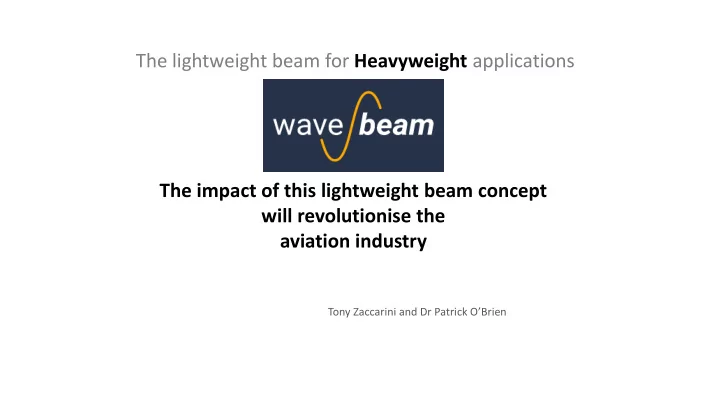

The lightweight beam for Heavyweight applications The impact of this lightweight beam concept will revolutionise the aviation industry Tony Zaccarini and Dr Patrick O’Brien
The lightweight beam for Heavyweight applications Patent Applied For : United Kingdom Patent Application No. 1905977.3 - IP Title: Wavebeam Wavebeam is a light-weight structural beam which has the ability to revolutionise the aviation industry. Because of its unique design, Wavebeam will carry similar loads as existing beams, but will be up to 40% lighter. Ultimately, the Wavebeam concept will be manufactured in other structurally efficient materials including but not limited to aluminium, carbon fibre reinforced polymer and composites.
Circa 40% lighter Welds Than a standard beam 5 mm steel flange welded on top and bottom of wave and pipes 5 mm Internal wave welded along the entire length of beam Top of beam 5 mm thick x 80 mm diameter steel pipe supports welded to the inner bends along the entire length of the internal wave The dimensions of a standard Wavebeam would be 300 mm wide x 400 mm deep
Gun barrel hole configuration 5mm Wavebeam Further development of standard Wavebeam to include holes as an additional weight saving option 3mm Wavebeam Lite Wavebeam Lite would be solid with no holes cut out along the wave
The lightweight beam for Heavyweight applications Steel pipes are welled to the inside curve of the wave and to the upper and lower flanges, adding further compression support to the beam. Note :- At the point where the pipes meet the wave, the thickness at the intersection increases from 5 mm to 10 mm. This further supports the loading capacity on the edges. As the wave and pipes alternately deviate from one side of the beam to the other, there is less likelihood of it buckling under extreme pressures.
The lightweight beam for Heavyweight applications The Critical Design Factors in Wavebeam being a successful design include the thickness of steel which is used, and the various elements including flanges, wave and cylinders Other factors such as the angle of wave deviation, circumference of cylinders and position and width of flanges relative to the depth of beam, all play a critical role in Wavebeam being an effective product This successful design has the ability to withstand extreme lateral torsional forces.
An extensive Literature Review was carried out by the University of Strathclyde prior to the Wavebeam model being developed and tested
The lightweight beam for Heavyweight applications Sample analyses of Strathclyde results Case 2: 4-Point Bending
The lightweight beam for Heavyweight applications Sample analyses of Strathclyde results Case 3: Web buckling
The lightweight beam for Heavyweight applications Sample analyses of Strathclyde results Case 4: LTB EigenVale Analysis
The lightweight beam for Heavyweight applications The future development of the aviation industry
The lightweight beam for Heavyweight applications Contact us directly for further information Tony Zaccarini and Dr Patrick O’Brien
Recommend
More recommend